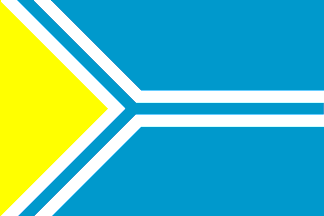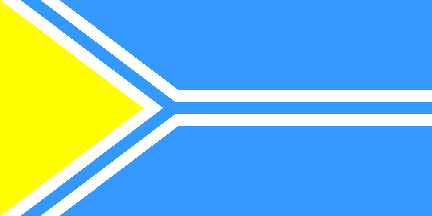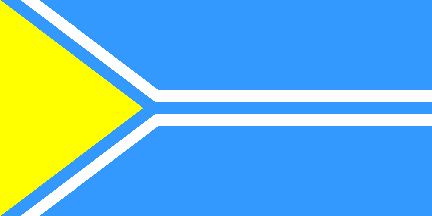
Last modified: 2014-03-09 by zoltán horváth
Keywords: tuva | error | tyva |
Links: FOTW homepage |
search |
disclaimer and copyright |
write us |
mirrors

(Note: You need an Unicode-aware software and font to correctely view the cyrillic text on this page. See here transliteration details).
Tuva broke away from Mongolia in 1921, and retained its independence
until incorporation into the USSR in 1944. In 1961, it became an ASSR.
In 1992, a new flag of light blue, yellow and white was adopted.
Stuart Notholt, 25 Nov 1995
Tuva is currently an autonomous republic of Russia, but
was previously independent. The
area is near the border between
Siberia and
Mongolia, and
is also claimed by China (I think that
Taiwan even has a representative in
their legislature for Tuva, or at least they used to).
Annie Platoff
Tuva borders Mongolia to the
south and has a short border with
Buryatia to the east.
Tuvinian is a Turkic language and is most closely
related to Uighur, spoken in the Chinese region
of Sinkiang.
Vincent Morley, 19 Nov 1997
The original Tuvan flag
adopted in 1918 was also
blue, yellow and white. Today, the colours are
said to represent courage and strength in blue,
prosperity in yellow and purity in white.
Vincent Morely, 19 Aug 1997,
quoting [rya97]
Present flag of Tuva was designed by Oyun-ool Sat 18 September 1992.
White suggests silver (clean thoughts) and the silver streamers draped
over a hostess’ arms as she greets guests. Yellow suggests gold (riches)
as well as Buddhism. Light blue suggests the courage and firmness of the
nomadic herdsmen (and the big blue Tuvan sky!). The stripes represent the
confluence of the Bii-Khem and Kaa-Khem rivers at Kyzyl, where they form
the Ulug-Khem (Yenisei).
Dave Martucci 15 Mar 1998,
quoting Kerry Yackoboski
The Pantone colours proposed by
The Flag cabinet (Jiri Tenora, Berlin)
are: B- (PMS 285), Y (PMS 116).
Pascal Vagnat, 03 May 1998
Jiri Tenora’s proposal for the
blue is too dark. The many potographs
we have show a lighter shade: PMS 292
or even 291 is more correct. (The
picture above shows the colors very
good).
Ralf Stelter, 27 Jun 1999
The legislation about the State flag of the Republic of Tuva, of 17
September 1992 was superseded by the Law _About the
State symbols of the Republic of Tuva_ No. 697 of 31 December 1996 (Chapter
III devoted to the flag), with no changes in the description or measures.
The Law _About the State flag of the Republic of Tuva_ No. 1302 of 8
February 2002 establishes new proportions 2:3, remaining the construction
details untouched. This Law
abolished Chapter III of the previous Law of 1996.
Antonio Gutierrez, 25 Jun 2006


This (in medium blue) flag is listed under number 122 at the chart
Flags of Aspirant Peoples [eba94]
as: «Tuva Ulus (Tuvinian Mongols) - South Siberia». Similar to the
real flag, but no white stripe between the yellow triangle and the
blue field.
Ivan Sache, 15 Sep 1999
I wander if the missing white stripe is simply an error or if
it has a meaning as a variation of the Tuvan flag — for what is
worth, "Tuvinian Mongols" are simply Tuvans (or Tuvinian).
António Martins, 16 Sep 1999
ty.gif)
This emblem is remarkably similar to the one on the
1933-1941 flag.
António Martins, 15 Feb 2000
According to “State Flags and Coats
of Arms of Tuva” by Prof. V.A. Sokolov
[sol83a],
which appeared in the Flag Bulletin,
[tfb] issue
100 (May-Aug. 1983), there were
seven flags used between 1921 and 1944,
although only five were legally adopted. Add to that the two
ASSR Flags and the present
flag, making 10 flags in all since 1921.
Dave Martucci, 15 Mar 1998